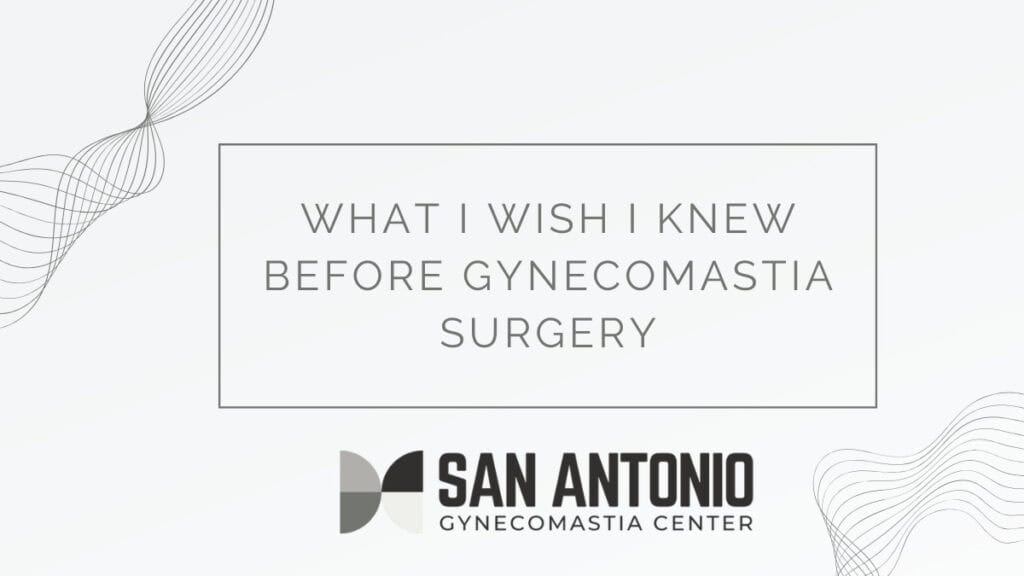At San Antonio Gynecomastia Center, we meet many men who have quietly dealt with gynecomastia for years. It’s a condition that can affect every part of daily life, from how you dress to how you carry yourself.
In this post, we’re sharing the story of a 35-year-old teacher from San Antonio, TX. For most of his adult life, he lived with gynecomastia and the self-consciousness it caused. He had always believed that surgery was only for extreme cases, or that he just needed to “work out harder.”
He will now share his story and what he wishes he had known earlier in his journey.

The Mental Toll of Living With Gynecomastia
I used to think I was the only one dealing with this. I wasn’t overweight. I went to the gym. I ate pretty clean. But no matter what I did, my chest looked soft and round.
For a long time, I didn’t even know it had a name. I thought I just had “stubborn fat.”
Every summer in San Antonio was a nightmare. I avoided swimming pools and BBQs. I wore undershirts beneath every T-shirt, no matter how hot it was. I even stopped wearing white clothes because I felt like they made my chest look worse.
The hardest part? I never talked about it. Not to friends, not to my partner, not even to my doctor. I just silently hoped it would go away.
Realizing I Couldn’t Fix It on My Own
In my early 30s, I started training for a half marathon. I dropped about 20 pounds and felt healthier than I had in years, but my chest looked exactly the same. That’s when I finally admitted to myself that this wasn’t something I could change with cardio or diet.
I started researching and came across the term “gynecomastia.” Once I learned that this was a real medical condition and not just fat, everything changed.
That’s how I found the San Antonio Gynecomastia Center.
What Helped Me Finally Take Action
I kept the tab open on my phone for weeks before I booked the consultation. I wasn’t nervous about the surgery, rather I was nervous about being judged.
But from the very first phone call, I felt at ease. Here’s what stood out during my experience:
- Specialized expertise: This wasn’t just a plastic surgery clinic. They clearly specialized in gynecomastia and had seen cases like mine many times.
- No shaming or confusion: The surgeon explained why exercise doesn’t always work, especially when the issue is glandular.
- A realistic plan: They gave me a clear breakdown of what the surgery would involve, including risks, timelines, and results.
- It wasn’t just cosmetic: They acknowledged the emotional toll gynecomastia takes, which made me feel understood.
After the consultation, I didn’t need more time to think. I scheduled my surgery that same day.
Misconceptions I Wish I Could Clear Up
Looking back, I realize how much misinformation and misunderstanding had kept me stuck.
If I could go back, these are the things I’d want to tell my younger self:
- You can be fit and still have gynecomastia: I had visible abs but still had a puffy chest. That disconnect made me feel crazy.
- It’s not your fault: No amount of pushups or protein shakes would have fixed this. The gland had to be surgically removed.
- Surgery is safe and effective: I was back at work in under a week and back to the gym (with restrictions) a few weeks later.
- Scars are minimal: The incisions were tiny and placed near the areola. At three months out, they were barely visible.
- You’re not alone: Once I opened up, I found that several people I knew had struggled with the same thing.
Most of all, I wish I had known how much better I would feel afterward.
Surgery and Recovery
I expected to feel pain after surgery, but it was mostly soreness and tightness. I took a few days off work and used that time to rest, wear the compression vest, and keep my body moving with short walks.
Key Recovery Milestones
Here’s how my recovery played out:
- Days 1–3: Rested a lot. Took over-the-counter pain meds. Compression vest helped with swelling.
- Day 4: Started doing light chores. No heavy lifting, but felt fine walking around.
- Week 2: Most swelling had gone down. Bruising faded. Went back to teaching without issues.
- Week 4: Got clearance to resume light workouts. No chest exercises yet, but I was feeling more like myself.
- Week 6+: Back to full gym routine. Chest looked flat and natural. Confidence started building fast.
By staying consistent with follow-up visits and wearing the garment as recommended, my healing went smoothly.
Life After Gynecomastia Surgery
I didn’t realize how much mental energy I had been wasting before surgery. I used to check mirrors constantly. I’d avoid hugs or situations where someone might touch my chest.
Now? I barely think about it.
Everyday Things That Changed for the Better
A few changes caught me off guard in a good way:
- Wearing just one T-shirt: I can throw on a shirt without worrying if it hides anything.
- Confidence in photos: I don’t have to angle my body or fold my arms anymore.
- More motivation to stay active: Now that my body matches the effort I put in, I feel even more committed to fitness.
- Emotional relief: There’s a calmness that comes with no longer obsessing over one part of your body.
Thinking About Surgery? Here’s What I’d Say
If you’ve been quietly dealing with gynecomastia, I get it. It can feel isolating. But there are solutions, and you don’t have to live with it forever.
Don’t wait as long as I did. Even if you’re not ready for surgery today, start by having a conversation.
Considering Gynecomastia Surgery in San Antonio?
At San Antonio Gynecomastia Center, we focus on helping men take the first step toward lasting confidence. Whether you’re just beginning to explore options or already know what you want, we’re here to guide you.
Reach out today to schedule a male breast reduction consultation and learn what treatment might look like for you.



